Affiliate disclosure: This post may contain affiliate links. Please see our Privacy Policy.
I remember the first time I saw a ground cherry. They’re not something I’d seen, or even heard of, growing up on the west coast.
I was selling baked goods at a small rural farmers market and a young girl came up to my table and asked if I wanted to trade. She didn’t say what, but all she wanted was a cupcake. Sure, why not?
She ran home and came back with a pint of freshly picked ground cherries that completely blew my mind. How on earth did she grow something that tastes like a cross between a strawberry and a pineapple in her backyard in Vermont?
Since then, I’ve made a point of growing husk cherries every year. They’re productive, and take almost no tending to produce huge crops of ridiculously tasty fruit.
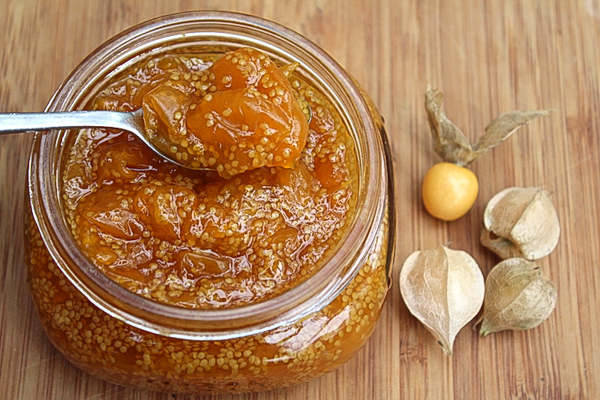
You can find ground cherries at farmer’s markets, especially on the east coast. Because of their novelty, they tend to be a bit expensive.
A single plant can produce as much as a gallon of fruit, so growing your own ground cherries is a much better bet. Ground cherry seed is available here.
Ground cherries are often called husk cherries because they grow inside a papery husk, like tomatillos. Once picked, they’ll keep on the counter in the husk for months if you pick carefully and don’t bruise them. They’re magic that way.
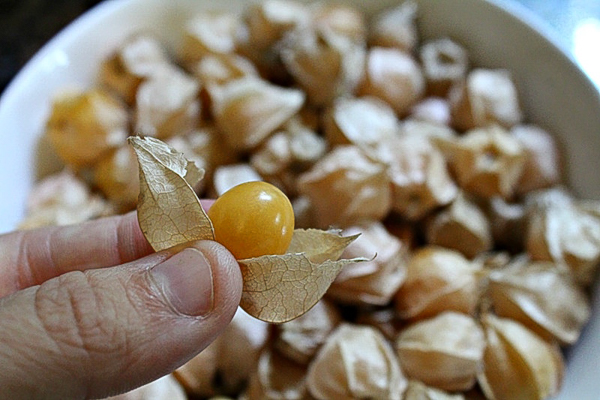
Even though they keep well in the husk, I still like to make homemade ground cherry preserves. Not for the preservation, but for the flavor. Recipes vary in sugar, but as a rule, I try to add as little sugar as possible. I want to taste the fruit.
Some recipes have you add as much as 1 cup of sugar to 1 cup of fruit. I prefer a much lower ratio, using somewhere between 1/2 and 1 cup of sugar to 3 cups of fruit. It’s still very sweet, don’t worry.
Honestly, a full cup of sugar makes it too sweet for my tastes, so I stick to 1/2 cup. If you like tart jam as I do, go with a half a cup, otherwise, add a full cup to 3 cups of fruit. With a full cup, the tartness of the fruit just barely comes through.
With ground cherries, in particular, I like to use turbinado or demerara sugar because the molasses in the sugar adds a caramel richness to the finished jam. With a short cook time, ground cherries will thicken into a nice jam without the need for any additional pectin.
Since there’s so much water in husk cherries, it takes a surprisingly long time to cook them into jam. Add the sugar and lemon juice to the fruit and start it simmering. It’ll take between 35 and 45 minutes to reach jam consistency or gel stage.
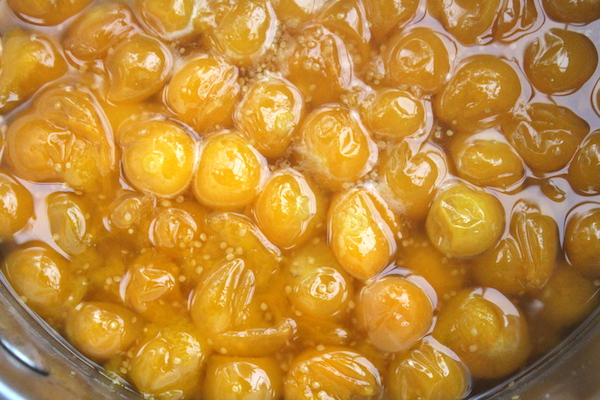
If you’re an experienced jam-maker, you know what gel stage looks like. The consistency will change rather suddenly, and it’ll thicken to where it takes a moment for it to fill back in if you part the jam in the pan with a spoon. Generally, this happens at 220 degrees at sea level.
Since I’m at 1000 feet of elevation, gel stage is at roughly 218 degrees. Adjust down about 1 degree F for every 500 feet of elevation gain.
For husk cherry jam though, I like the finished product to be a bit looser, and I finish it at about 216 degrees. It’s all up to you, finish your jam however you like, thick or thin.
This year I’m hoping to branch out beyond ground cherry jam, and I’ve put together a collection of other ground cherry recipes as well, check them out if you have extra fruit.
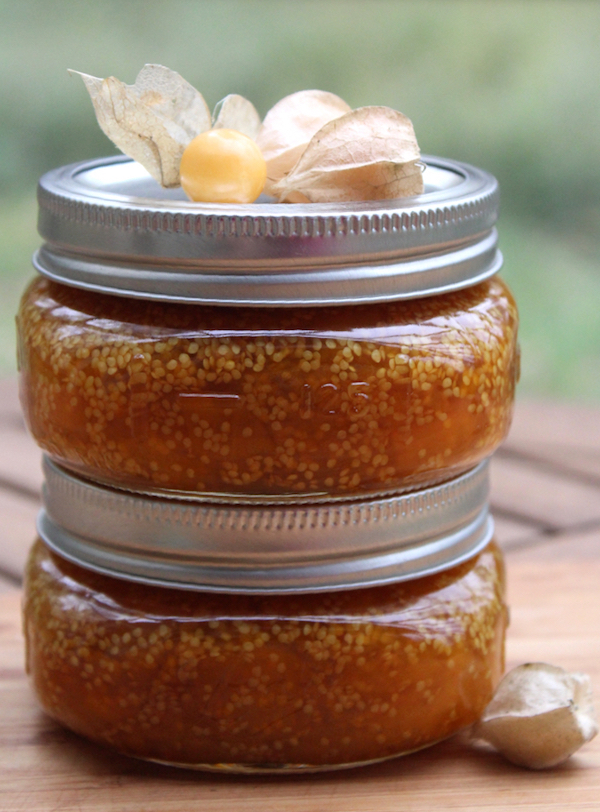
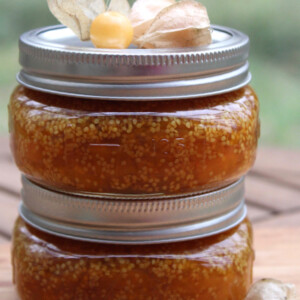
Ground Cherry Jam Recipe
Equipment
Ingredients
- 3 cups Ground Cherries, husked, about 5 pints in husks, or 2 pounds
- 1 cup Sugar
- 2 Tbsp Lemon Juice, bottled
Instructions
- Husk the ground cherries and add them to a saucepan.
- Add the lemon juice and cook over low heat until the ground cherries have popped and released their juices. Give it a stir to break them up a bit.
- Add the sugar and cook over medium heat until the jam thickens, about 15 minutes.
- Pour into clean quarter pint mason jars, leaving 1/4 inch headspace and store in the refrigerator or process in a water bath canner for 5 minutes.
Notes
Nutrition
Nutrition information is automatically calculated, so should only be used as an approximation.
More Fall Canning Recipes
Looking for more fun harvest time canning recipes? Read on my friends…
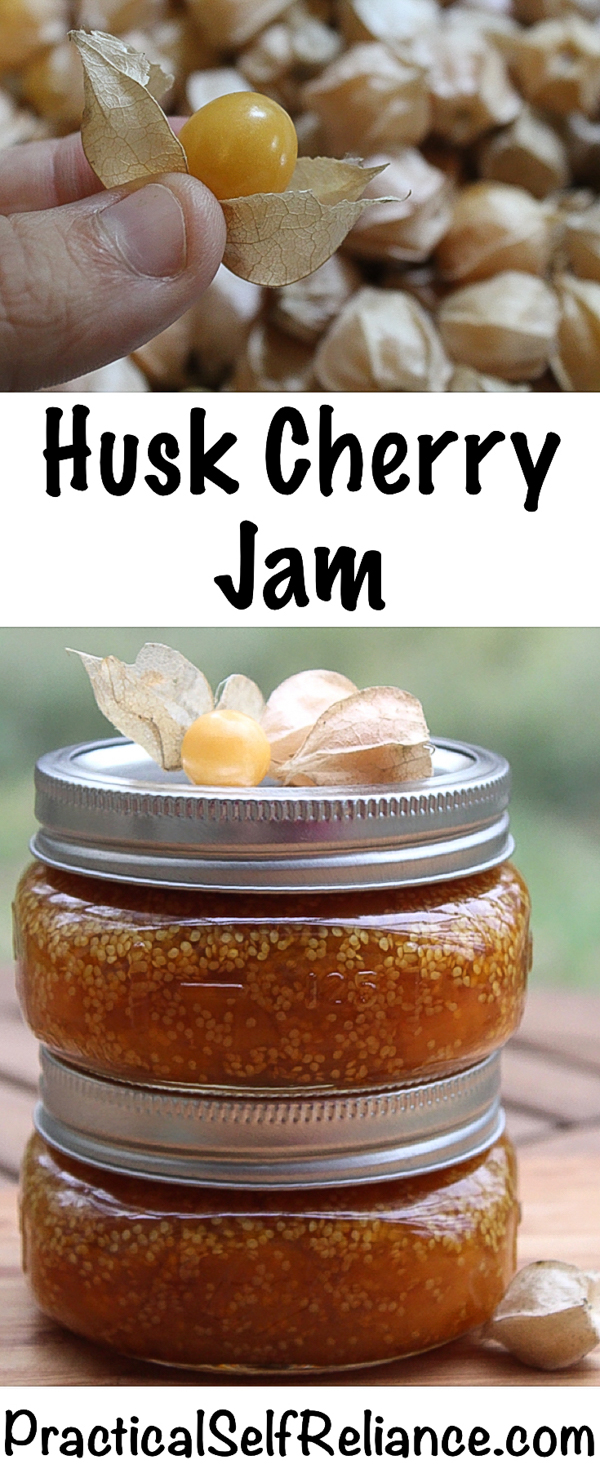
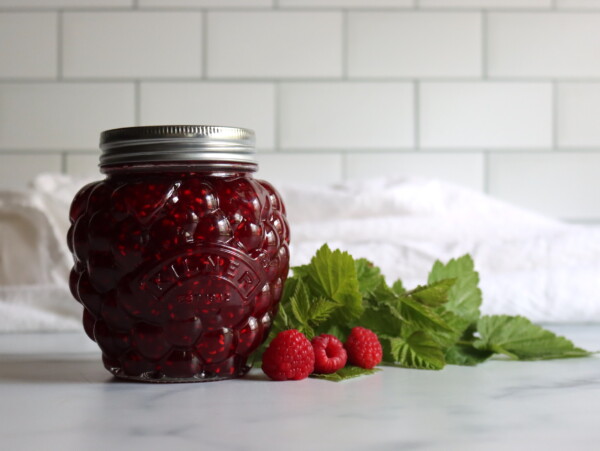
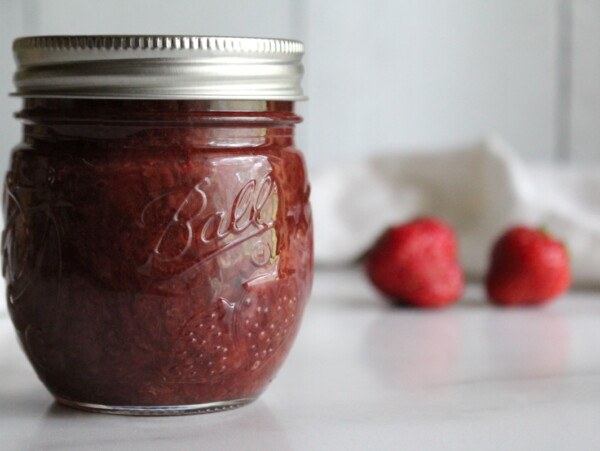
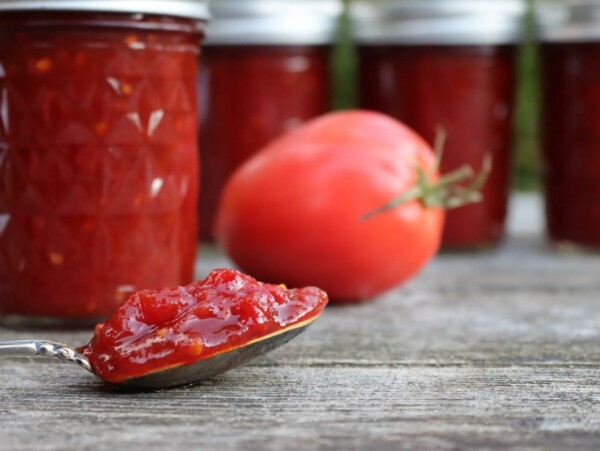
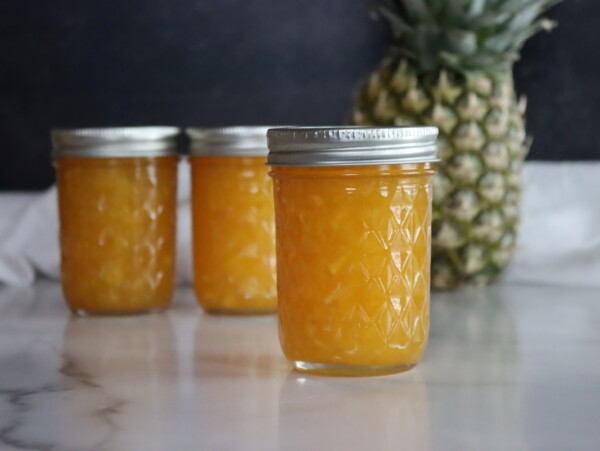
Thanks for your nice article and recipe . Hoping more gardeners will discover this easy to grow and care for plant. My grandma grew these back in the 1920s. I too have been growing these and making this gorgeous jam for many years.
I know, right? They’re so delicious, I can’t believe they’re not more common!
I have been making this for years and love the novelty of having ground cherries year-round in this jam.
Wonderful!
I’ve used this recipe several years in a row now for my garden’s prolific ground cherries. These little jars have been a hit at the holidays, and made it relatively easy to put a personal touch on gifts. Thank you for sharing! <3
So glad you enjoyed it!
Would you use the same ratio/amount if you swapped out the sugar for honeu
It is generally recommended that you use about half the amount of honey as sugar. I would also recommend using a commercial pectin.
Since the ph you researched is lower than tomatoes, would it be safe to use ground cherries in place of tomatoes in a canning recipe for salsa, chutney, etc? I have only found fresh ground cherry salsa recipes, but it makes sense to me that I should be able to sub them for tomatoes in a recipe that has already been tested.
Yes, if it is a more acidic food, then it should be safe to do that swap.
I modified the recipe a bit for myself. I tripled the recipe, cut the sugar abit and added a pkg of lemon jello and a 1/4 tsp salt. It has been a hit at my house.
This jam is delicious, easy and fast to make. I tripled the recipe and yielded 8 (1/2 pint) jars. I cut the sugar to 3/4 cup instead of 1 cup (for a single recipe). I also added 1 pkg of lemon jello and 1/4 tsp of salt. The flavour is excellent.!
So glad you enjoyed the recipe.
This is amazing! I bought ONE of these plants, labeled ‘pineapple tomato’ and other than just snacking or in salad, I had no idea what to do with them. I have TONS! Will be making this this afternoon after I finish with the pickles. Knew I could find something on your site to help! Thank you!
Great! So glad the post was helpful.
I was searching for poha berry (our name In Hawaii) recipes, wanting to make a poha jelly for a friend who cannot handle the tiny seeds. (Diverticulitis). I’ve never made jelly.
I always made refrigerator jams before with this little golden gem. We go through it rather quickly into sauces and as well as on biscuits and toast! I’m going to try following the suggestion in the comments about cooking poha down with lemon juice first and then putting through a sieve. Correct? And then, proceeding with recipe? Mahalo.
Yes, that’s correct. Let us know how it turns out for you.
After seeing all the millions of tiny seeds I now know why I have about a billion plants sprouting their little heads everywhere in the garden. No need to buy new plant next year!
That’s fantastic.
Thank you so much for sharing this! This was my first year growing ground cherries and I had no idea what to do with all of them. Also my first time making jam and I let it simmer too long, but I can adjust for the next batch. Great, easy to follow directions.
You’re welcome. So glad you enjoyed the post.
I’m a little confused. In the article, it says “With a short cook time, ground cherries will thicken into a nice jam without the need for any additional pectin.” Then in the next sentence, it says, “Since there’s so much water in husk cherries, it takes a surprisingly long time to cook them into jam.” The recipe says it only takes 15 minutes cook time, yet the article says 35-45 minutes to reach the right consistency for jam. This all seems contradictory…
I can see why that might seem a bit confusing. I think that the 35-45 minutes in the blog is the total cook time. In the actual recipe it says to cook the cherries on low until they have popped and released their juices. After that has happened you will add the sugar and then continue to cook for an additional 15 minutes or until you have reached the proper temperature or desired consistency.
I burned this on medium heat within 15 minutes 😔
I am so sorry that happened. The recipes calls for cooking them on low first until the cherries have popped and released their juices and then you can turn the heat up to medium.
I’m excited to give this a try. If I skip the canning, do you think freezing the jam would work?
Yes, you should be able to freeze it just fine.
Just bought a pineapple ground cherry plant yesterday! Thanks for the recipe…. I’m eager to be picking these in a few months! I would rather use honey or maple syrup. Would they work? Love the suggestions of adding ginger & maybe jalapeno!!
Yes, you can definitely use honey or maple syrup. Enjoy!
This recipe is easy and great. Had a rogue ground cherry plant come up this year-,not enough so I added some cherry tomatoes. Turned out great. I am using your base for some sweet tomato jelly with a little heat. It’s nice to see comments for other ideas… ground cherries are so versatile. For people who are hinky on water baths and pressure cooking, I use the old fashioned oven method. Hasn’t killed any of us yet …lol. Simply put your hot canned and sealed jars in a cold oven, turn on at 350 degrees and bake for 30 minutes. Open oven door and let cool on its own,
I am so glad that you enjoyed the recipe. Please keep in mind that oven processing is not considered a safe method of canning. Here is a quote from the National Center for Home Food Preservation: “This can be dangerous because the temperature will vary according to the accuracy of oven regulators and circulation of heat. Dry heat is very slow in penetrating into jars of food. Also, jars explode easily in the oven.” It’s a good thing that you haven’t had a bad experience with this yet but it’s really not worth the risk. Water bath canning is a very simple process and this particular recipe only calls for a 5 minute processing time so it’s actually much faster as well.
This was amazing. I added ginger, and it’s out of this world.
Thanks Hope. So glad you enjoyed the recipe. I bet the ginger added a really nice touch.
It seems that I am one of the few lucky (or unlucky) ones who has way more ground cherries to use than this recipe is helpful for. As a new jam maker, I had no concept of how much jam would be produced from following this recipe, so I just followed it as is, and I ended up with just three quarter-pint jars. To me, that is not enough for the time and effort required. It would be helpful for the recipe to provide an approximation of how much is produced.
A couple questions for if I do try this again:
In the story before the recipe, it says to add the lemon juice and sugar together, but in the recipe it says to do that at different times. If separate times, should all of the ground cherries have popped before adding, or just a few? The amount of ground cherries in the recipe states 3 cups (2 lbs).
I didn’t have nearly 2 lbs in a generous 3 cups. So, I went with the cups measurement so as not to overdo the ground cherry to lemon juice ratio. Which is more accurate?
Thanks!
The yield on the recipe actually appears right above the title of the recipe portion of the blog post. It’s very difficult accurately measure something like this in a cup measurement. I think going with the cups measurement was fine. The lemon juice is really based more on the amount needed per jar of product in order to provide the right amount of acid to safely can. You can always add in a little more than is needed without harming the recipe, provided it still has a good taste. You definitely don’t want to use less though. Hope this helps.
Can I sub citric acid for the lemon juice? It’s what I have on hand. Thanks in advance!
Yes you can. Citric acid is more concentrated, so you need less. Details on the conversion here: https://pomonapectin.com/faq/can-i-substitute-citric-acid-or-ascorbic-acid-for-the-lemon-or-lime-juice-or-vinegar-called-for-in-a-pomonas-recipe/
Why am I having a hard time getting my ground cherries to pop. What can I do?
They’ll pop if you cook them nice and hot in a boiling pot. It takes a minute, so you might have to add a bit of water so the pot doesn’t run dry before they do. I’ve never had that problem myself, maybe you have a more resilient variety with thicker skins? You may have to cut them in half if that’s the case.